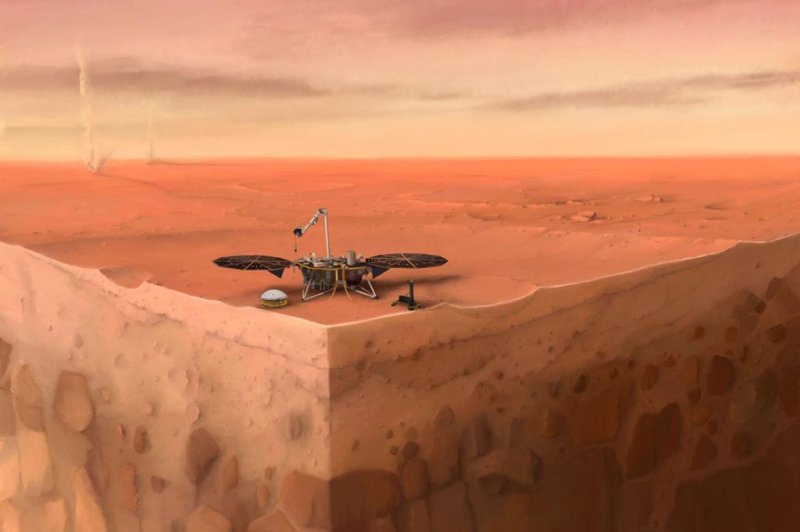Since touching down in late 2018, the InSight lander's seismometer has recorded more than 450 seismic events. Photo by IPGP/Nicolas Sarter
Feb. 24 (UPI) -- Researchers have published the first scientific papers that rely on data collected by NASA's InSight lander, which touched down on Mars just over a year ago.
Observations made by the lander's super-sensitive seismometer, the Seismic Experiment for Interior Structure, have allowed scientists to gain new insights into the structure of the Red Planet's interior.
In September 2019, InSight's seismometer recorded 174 seismic events. Since then, SEIS has recorded a total of 450 Marsquakes, an average of nearly two a day in recent months, but they have not yet been formally analyzed by scientists.
According to the new research, published Monday in the journal Nature, the quakes take two forms.
One type of Marsquake features low-frequency seismic waves and register magnitudes between 3 and 4 on the seismomter. There were 24 such quakes prior to November 2019.
The second family of quakes feature high frequency waves trapped in the Martian crust. These shallower quakes are smaller in magnitude and more common. SEIS recorded 150 such quakes prior to November 2019.
"Marsquakes have characteristics already observed on the Moon during the Apollo era, with a long signal duration -- 10 to 20 minutes -- due to the scattering properties of the Martian crust," study author Domenico Giardini, professor of geophysics at ETH Zurich in Switzerland, said in a news release.
Analysis of the seismic waves recorded by SEIS suggests the lander touched down on a shallow patch of sand. The sandy layer extends just a few feet beneath the surface. The initial analysis of Marsquakes suggests that below the sandy layer, the Martian crust is a lot like Earth's crystalline crust but more fractured.
Additionally, scientists suspect they dissipate more quickly in the Red Planet's upper mantle than in its lower mantle.
Mars is without tectonic planets, but it does boast volcanically active regions. As detailed in one of the Nature papers, scientists were able to link at least two larger quakes with one such region, Cerberus Fossae. Satellite images showed boulders were dislodged and tumbled down cliff sides around the time the quakes were recorded.
Cerberus Fossae is characterized by a pair of deep channels that were created by lava flows some 10 million years ago. These flows feature fissures that scientists suspect were created by rumblings resulting from volcanic activity. Some of the fractures may be as young as 2 million years old.
"It's just about the youngest tectonic feature on the planet," planetary geologist Matt Golombek of NASA's Jet Propulsion Laboratory said in a news release. "The fact that we're seeing evidence of shaking in this region isn't a surprise, but it's very cool."
The early scientific results from the InSight mission suggest the lander touched down during an unusually quiet period, in terms of seismic activity. Researchers expect a full Martian year of observations, two Earth years, will offer scientists more detailed insights into Mars inner composition.















